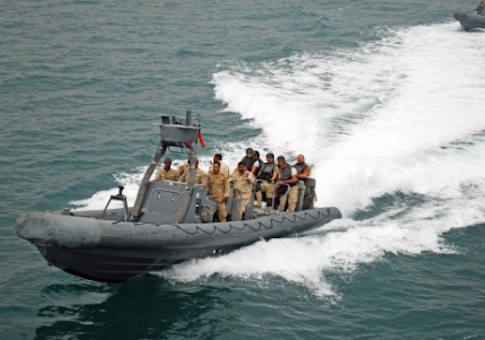Some 3,000 U.S. military personnel, including American "air, land, sea, and special operations components," have moved into the Persian Gulf region for a military exercise that coincides with the finalization of a nuclear agreement with Iran aimed at containing its nuclear arms program, according to officials from U.S. Central Command (CENTCOM).
The exercise, known as Eagle Resolve, has been taking place in Kuwaiti waters since March 8 and will run through the end of the month, when the United States is expected to announce a tentative framework agreement with Iran that is to serve as the final step toward a nuclear agreement.
This year’s exercise, which is taking place off Iran’s southern coast, "is the biggest to date," according to a readout of the exercise provided by CENTCOM officials. Military representatives from 29 U.S. allies are supporting the exercise.
The goal of the exercise, which has been in the works since January of last year, is to boost regional response time to potential incidents and practice tactical moves from the land, sea, and air, according to CENTCOM, which oversees military operations in the region.
"Eagle Resolve 2015 will consist of a week-long series of simulated ‘injects’ to exercise participants’ ability to respond as a multinational headquarters staff, followed by a series of tactical demonstrations of land, maritime, and air forces from several nations," CENTCOM said in a fact sheet about the exercise provided to the Washington Free Beacon. "The exercise ends with a senior leader seminar to foster an environment for commanders to discuss issues of regional interest."
While CENTCOM emphasized that the exercise is not meant to send a message to Iran, the timing is noteworthy. It comes as Iranian military leaders issue repeated threats to U.S. assets in the region and continue to unveil new weapons and warships aimed at combatting Western forces in the Gulf.
"The exercise is not intended as a signal to Iran," a CENTCOM official told Sunday, ahead of the March 24 deadline for U.S. officials to reach a framework agreement with Iran. "If there's any message at all, it's that all participants have a common interest in regional security."
"It's important to point out that this is a recurring exercise, with planning for this year's exercise beginning over a year ago," the official said. "The focus of the exercise is on bolstering capabilities useful in a wide range of scenarios to help preserve and bolster regional security, with simulated portions of the exercise based on a fictional adversary."
Sea-based weaponry has been a focus for Iran. The Islamic Republic secured an arms deal with Russia in January and sought submarines, torpedoes, and sea-based cruise missiles in order to boost its maritime power in the region.
Iranian warships also have been sailing across the region in a show of force meant to intimidate regional enemies and instill confidence in the Islamic Republic’s partner nations.
In keeping with this maritime military focus, Iran announced last week that it had begun to "mass produce" long range anti-ship cruise missiles, according to the country’s state-run PressTV.
"Today, we are simultaneously witnessing the launch of the mass production line and the delivery of this strategic and effective missile in the domain of defense and marine battle," Iranian Defense Minister Hossein Dehqan was quoted as saying upon the announcement.
Iranian naval officials vowed in May to "destroy the U.S. Navy" and said that suicide attacks and drone strikes would be part of this strategy.
Michael Ledeen, an Iran expert and former consultant to the National Security Council (NSC), the State Department, and the Defense Department, said that many of the Gulf countries participating in the exercise are worried about Iran’s moves in the region.
"Most of the [Gulf Cooperation Council] countries are deeply skeptical of American resolve and reliability, and military-to-military relations are enormously important as the Iranian threat becomes more intense," said Ledeen, a freedom scholar for the Foundation for Defense of Democracies (FDD). "Yemen, after all, is right there, and Iranian control over that major choke point is a direct threat to GCC control over the major sea routes."
The Eagle Resolve exercise will help manage border security for nations and tackle what CENTCOM calls "asymmetric threats."
"This year’s Eagle Resolve exercise scenarios range from air defense concepts to border security operations and counterterrorism operations as well as consequence management," the fact sheet states. "While participating nations have varying reasons for supporting Eagle Resolve, there is a common bond: we have a shared interest in regional security."
A combination of U.S. tactical forces from the Army, Marines, and other branches are assisting with the exercise, according to a CENTCOM official briefed on the details.
U.S. forces and its military allies have practiced helicopter exercises, such as ship-based search and seizure operations. Forces also will run exercises to execute amphibious landings along with the Kuwaitis, according to the official.
Most of the U.S. military assets participating in the exercise have already been stationed in areas around the region.
"Eagle Resolve is an excellent opportunity to improve our ability to partner with Gulf and international forces at the operational level and identify best practices in countering asymmetric threats," CENTCOM says.
This is the first time the Kuwaiti government has hosted the exercise.
